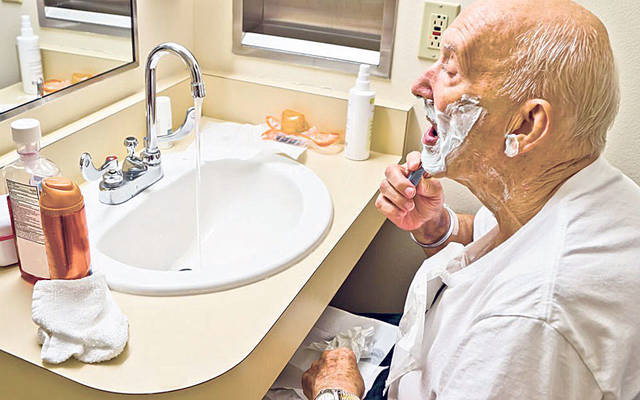Accommodating mobility, vision issues promotes aging in place

COURTESY DREAMSTIME / TRIBUNE NEWS SERVICE
Bathrooms present challenges for seniors, especially for those in wheelchairs. Cabinets will need to be removed to provide access to the sink, and toiletries will need to be placed lower, within reach.
When Dan Bawden teaches contractors and builders about aging in place, he has them get into a wheelchair. See what it’s like to try to do things from this perspective, he tells them.
That’s when previously unappreciated obstacles snap into focus.
Bathroom doorways are too narrow to get through. Hallways don’t allow enough room to turn around. Light switches are too high and electrical outlets too low to reach easily. Cabinets beneath a kitchen sink prevent someone from rolling up close and doing the dishes.
It’s an “aha moment” for most of his students, who’ve never actually experienced these kinds of limitations or realized so keenly how home design can interfere with — or promote — an individual’s functioning.
About 2 million older adults in the U.S. use wheelchairs, according to the U.S. Census Bureau; another 7 million use canes, crutches or walkers. That number is set to swell with the aging population: Twenty years from now, 17 million U.S. households will include at least one mobility-challenged older adult, according to a December report from Harvard University’s Joint Center for Housing Studies.
How well has the housing industry accommodated this population?
Don't miss out on what's happening!
Stay in touch with breaking news, as it happens, conveniently in your email inbox. It's FREE!
“Very poorly,” said Bawden, chairman of the remodelers division at the National Association of Home Builders and president of Legal Eagle Contractors in Bellaire, Texas. “I give them a D.”
Researchers at the Harvard center found that fewer than 10 percent of seniors live in homes or apartments outfitted with basic features that enhance accessibility — notably, entrances without steps, and extra-wide hallways or doors needed for people with wheelchairs or walkers.
Even less common are features that promote “usability” — carrying out the activities of daily life with a measure of ease and independence.
Laws that guarantee accessibility for people with disabilities go only so far. The Americans with Disability Act applies only to public buildings. And while the Fair Housing Act covers apartments and condominiums built after March 1991, its requirements aren’t comprehensive, and enforcement is spotty.
We asked several experts to describe some common issues mobility-challenged seniors encounter at home, and how they can be addressed. The list below is what they suggested may need attention and has suggested alterations, but is not comprehensive.
>> Getting inside: A ramp will be needed for homes with steps leading up to the front or back door when someone uses a wheelchair, either permanently or temporarily. The estimated price for a 5- to 6-foot portable nonslip version: $500 to $600.
You’ll want to take out the weather strip at the bottom of the front door and replace it with an automatic door bottom. “You want the threshold to be as flat as the floor is,” Bawden said. Consider installing an electronic lock that prevents the need to lean in and insert a key.
>> Doors: Getting through doorways easily is a problem for people who use walkers or wheelchairs. They should be 34 to 36 inches wide to allow easy access, but almost never are.
Widening a doorway structurally is expensive, with an estimated cost of about $2,500. A reasonable alternative: swing-free hinges, which wrap around the door trim and add about 2 inches of clearance to a door.
>> Clearance: Ideally, people using wheelchairs need a 5-foot-wide path in which to move and turn around, Bawden said. Often that requires getting rid of furniture in the living room, dining room and bedroom.
>> Reach: People in wheelchairs have a reach of 24 to 48 inches. That means they won’t be able to reach items in cabinets above kitchen counters or bathroom sinks. Also, light switches on walls will need to be placed no more than 48 inches from the floor, and electrical outlets raised to 18 inches from their usual 14-inch height.
>> Lighting: Older eyes need more light and distinct contrasts to see well. A single light fixture hanging from the center of the dining room or kitchen probably won’t offer enough illumination.
You’ll want to distribute lighting throughout each room and consider repainting walls so their colors contrast sharply with your floor materials.
“If someone can afford it, I put in recessed LED lights in all four corners of the bedroom and the living room, and install closet rods with LED lights on them,” Bawden said. LED lights don’t need to be changed as often as regular bulbs.
>> Kitchen: Mark Lichter, director of the architecture program for Paralyzed Veterans of America, recommends that seniors who use walkers or wheelchairs take time in the kitchen of a unit they’re thinking of moving into and imagine preparing a meal.
Typically, cabinets need to be taken out from under the sink, to allow someone with a wheelchair to get up close, Lichter said. The same is true for the stovetop: The area underneath needs to be opened and control panels need to be in front.
Refrigerators with side-by-side doors are preferable to those with freezer areas on the bottom or on top. Slide-out, full-extension drawers maximize storage space, as can Lazy Susans in the corner of bottom cabinets.
>> Laundry: Get a side-by-side, front-loading washer and dryer to allow for easy access, instead of machines that are stacked on top of each other.
>> Bathroom: When Jon Pynoos’ frail father-in-law, Harry, who was in his 80s, came to live in a small cottage in back of his house, Pynoos put in a curbless shower with grab bars and a shower seat and a handheld shower head that slid up and down on a pole. Even a relatively small lip at the edge of the shower can be a fall risk for someone whose balance or movement is compromised.
Also, Pynoos, a professor of gerontology, public policy and urban planning at the University of Southern California, installed nonslip floor tile and grab bars around a “comfort height” toilet.
Cabinets under the sink will need to be removed, and storage space for toiletries moved lower. A movable toilet paper holder will be better than a wall-based unit for someone with arthritis who has trouble extending an arm sideways.
“It really wouldn’t take much effort or expense to design homes and apartments appropriately in the first place, to make aging-in-place possible,” Pynoos said. Although “this still doesn’t happen very often,” he noted that awareness of what’s required is growing and that well-designed, affordable products are becoming more widely available.





